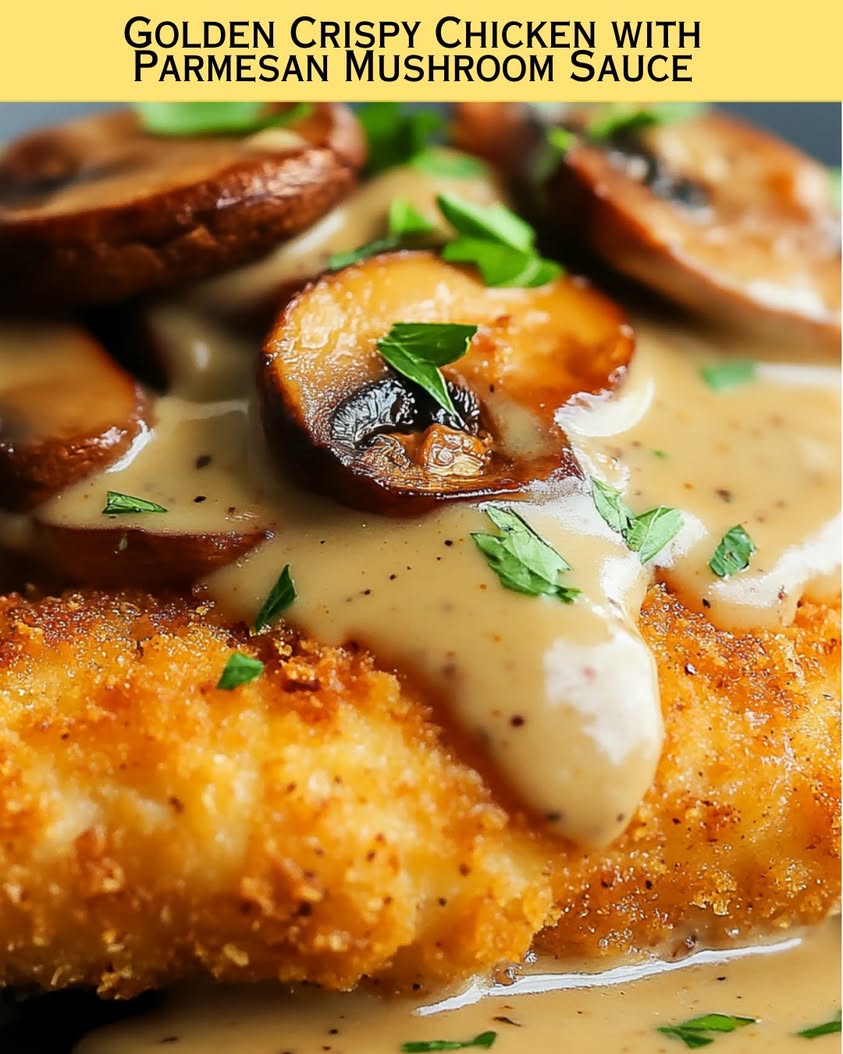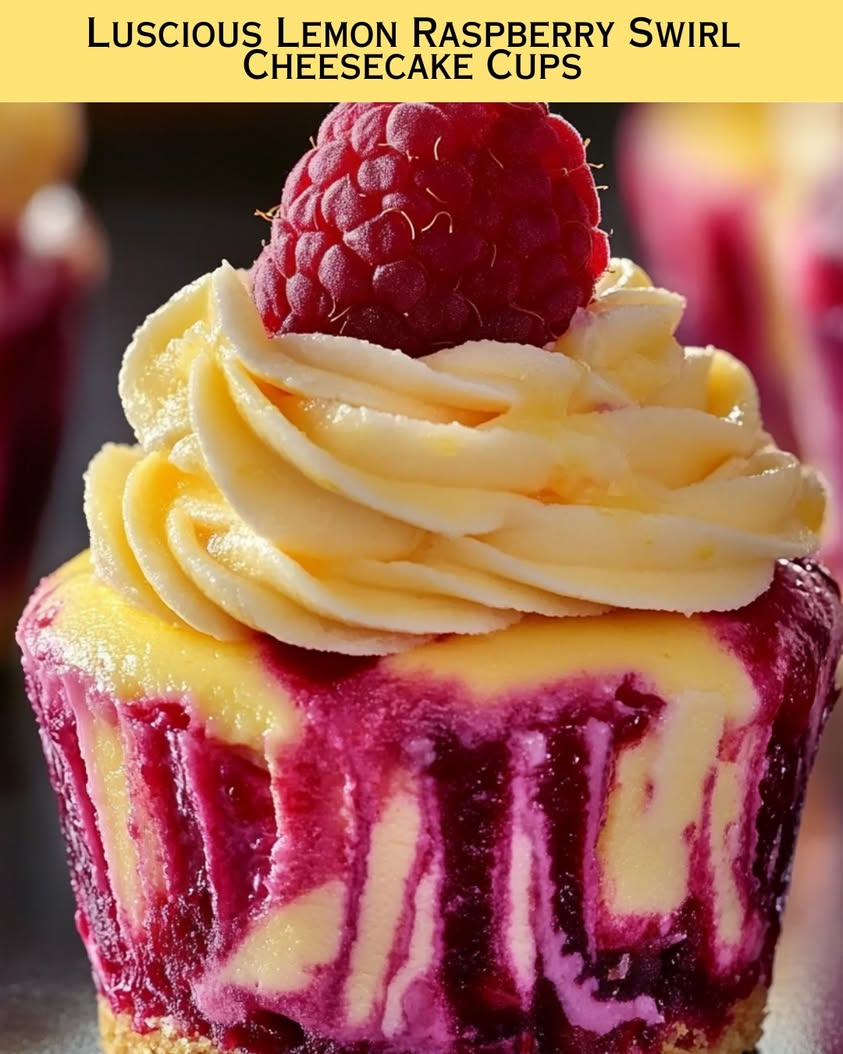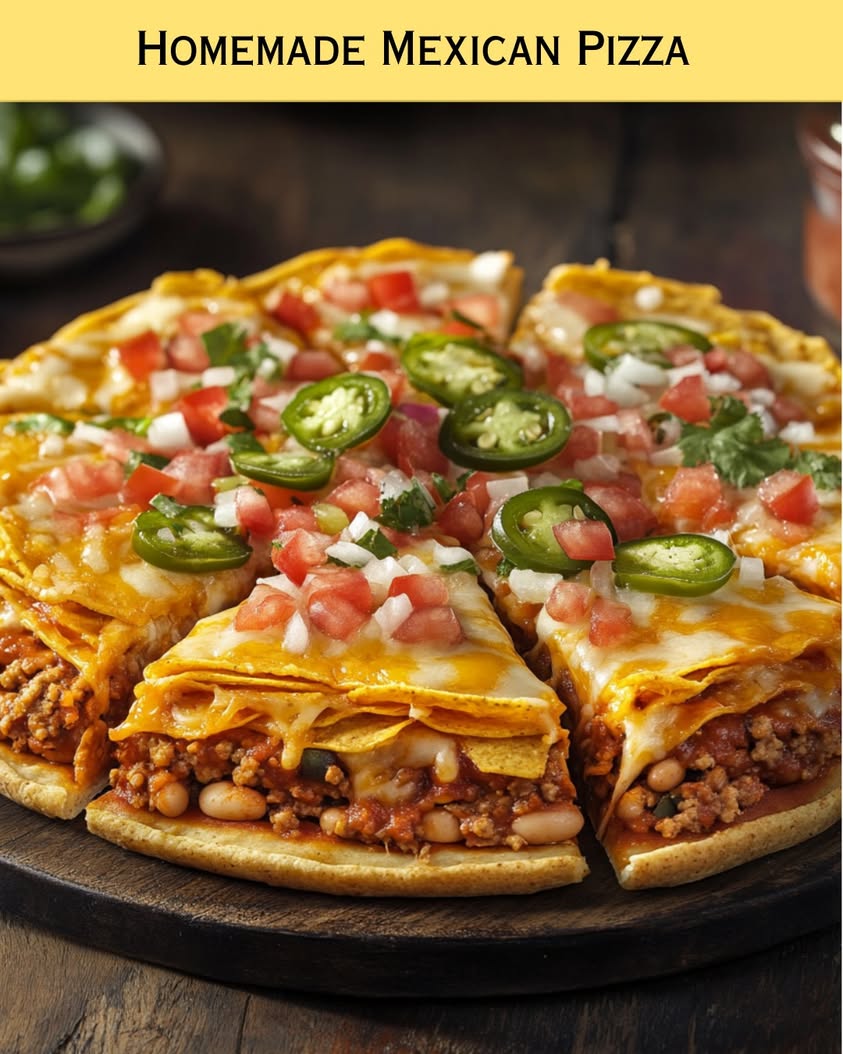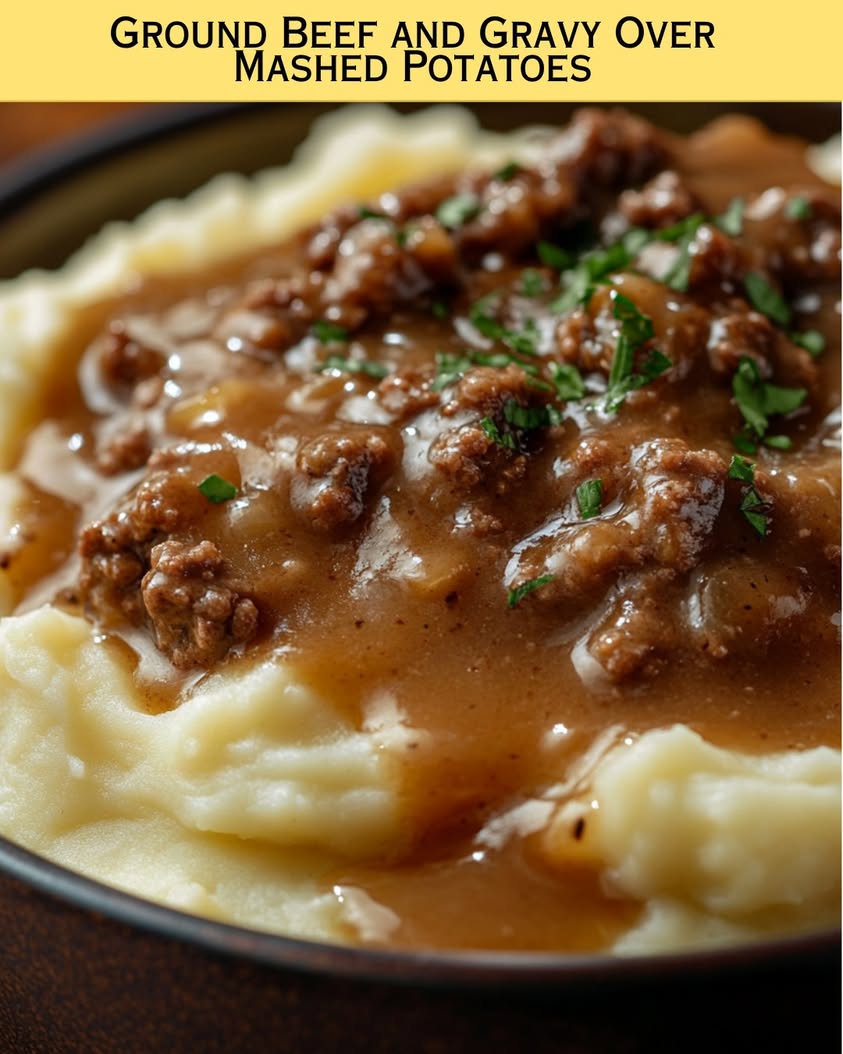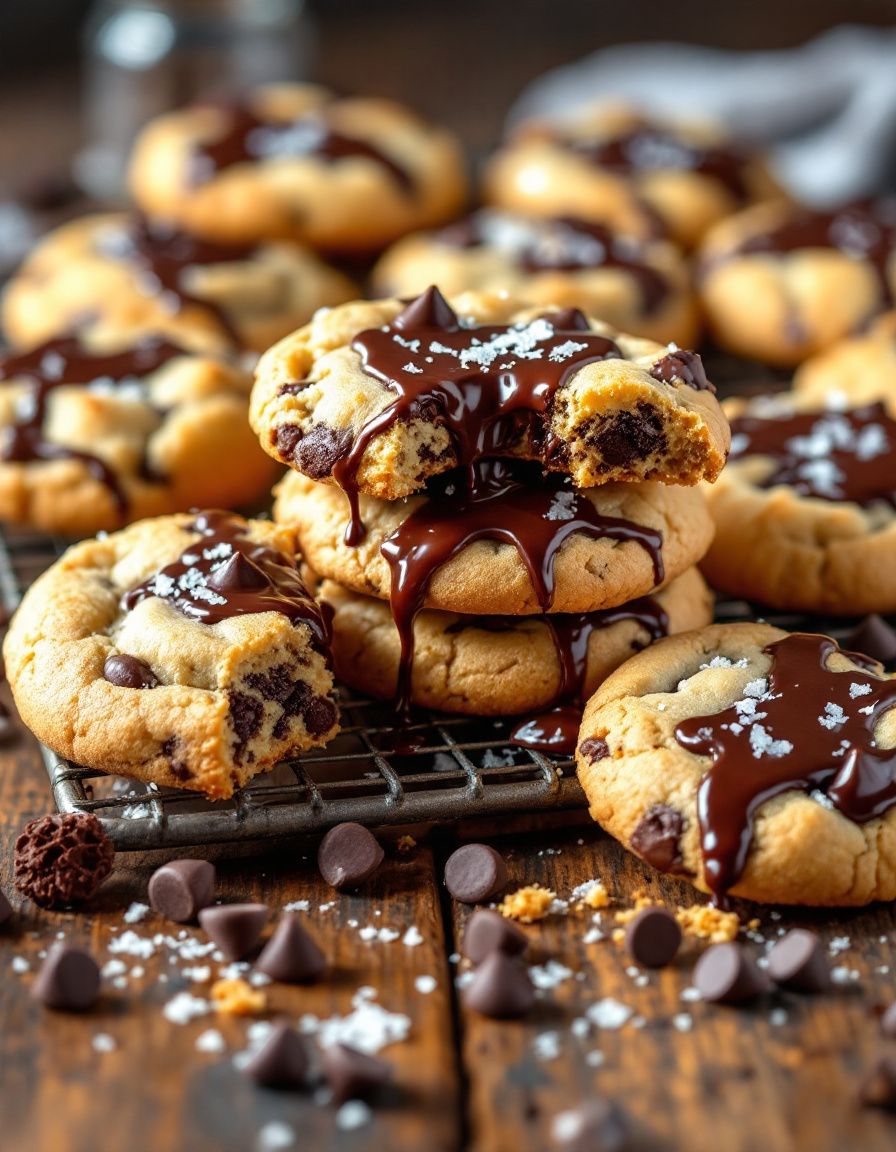Golden Crispy Chicken with Parmesan Mushroom Sauce: A Savory Delight
Welcome to a culinary experience that intertwines the delightful crunch of golden crispy chicken with the rich, savory allure of Parmesan mushroom sauce. This recipe is not just about serving a meal; it’s about crafting an emotional connection with the comfort of home-cooked flavors. Imagine biting into a perfectly cooked chicken breast, its outer shell coated in a crispy texture that gives way to juicy, tender meat, all while drizzled with a creamy sauce bursting with mushroom umami and cheesy goodness.
Whether it’s a weeknight dinner or a special occasion, this Golden Crispy Chicken with Parmesan Mushroom Sauce promises to impress your loved ones at the dinner table. The marriage of textures—from the crisp outside to the luscious inside—creates an unforgettable dining experience that will leave everyone asking for seconds. Each component, thoughtfully chosen and prepared, enhances the overall flavor profile, ensuring a full-bodied taste journey.
Quick Recipe Highlights
- Flavor Profile: The crispy chicken pairs perfectly with a creamy Parmesan mushroom sauce, creating a delightful blend of savory and umami flavors.
- Texture: A satisfying crunch on the outside contrasts beautifully with the juicy chicken inside, complemented by the velvety sauce.
- Aroma: The rich aroma of sautéed mushrooms and garlic adds an enticing element that fills the kitchen as you cook.
- Visual Appeal: The dish presents beautifully with its golden-brown chicken, creamy sauce, and specks of parsley for a pop of green.
- Skill Level Needed: This recipe is easy and suitable for novice cooks wanting to create a restaurant-quality dish at home.
- Special Equipment: Just a few basic kitchen tools—a frying pan and a pot—make this recipe accessible and convenient.
Recipe Overview
- Difficulty Level: This recipe is rated easy, making it perfect for both beginner and experienced cooks. It involves simple cooking techniques without requiring extensive culinary skills.
- Category: This dish is ideal for dinner, but it can also serve as a delightful lunch option, pairing seamlessly with salads or roasted vegetables.
- Cuisine: Drawing influence from Italian cooking, this recipe showcases the richness of Parmesan cheese and the depth of mushroom flavor familiar in many Italian dishes.
- Cost: The ingredients are budget-friendly, making this recipe accessible. Expect to spend around $15-20 for a meal serving four.
- Season: Enjoy this dish year-round, but it resonates well in fall and winter when creamy flavors are particularly comforting.
- Occasion: Perfect for family dinners, weekend gatherings, or comforting meals after a long day, it’s sure to be a hit on any table.
Why You’ll Love This Recipe
This Golden Crispy Chicken with Parmesan Mushroom Sauce unveils an alluring taste and texture that captivates the palate. The succulent chicken, enveloped in a crispy coating, catches the essence of indulgent flavors, making each bite a delightful experience. Coupled with the savory Parmesan mushroom sauce, this dish encapsulates a depth of flavor that resonates well with comfort food lovers, ensuring satisfaction for everyone at the table.
Convenience is another reason to love this recipe. It’s straightforward, requiring minimal advanced preparation. With just 15 minutes of prep time and 30 minutes of cooking, you’ll have a delectable meal ready to serve to family or friends. This makes it an excellent choice for busy weeknights or spontaneous desires for something delicious without spending hours in the kitchen.
In addition to being a tantalizing recipe, this dish boasts nutritional benefits. Chicken is a fantastic source of lean protein, while mushrooms add dietary fiber and essential B vitamins. The Parmesan cheese in the sauce enhances the flavor profile while also contributing calcium and protein, making this dish a balanced option to enjoy guilt-free.
Furthermore, the social aspect of this dish elevates its appeal. The process of gathering around the table to enjoy a hearty meal fosters connections among family and friends. Whether it’s a casual meet-up, a festive gathering, or a cozy dinner, this recipe allows for reminiscing over delicious flavors that create lasting memories.
Lastly, it’s hard to overlook the cost-effectiveness of this recipe. Using affordable ingredients that are often staples in most kitchens proves that delicious meals don’t need to be expensive. With a quick trip to the grocery store, you can have this dish ready on a budget without compromising on flavor or quality.
Historical Background and Cultural Significance
The roots of the crispy chicken dish hail from traditional fried chicken varieties, celebrated in many cultures for centuries. From Southern U.S. cuisine to various European influences, the technique of frying chicken has evolved, but the love for it remains constant across generations. This recipe adapts that time-honored practice by introducing rich flavors of Parmesan and mushrooms, showcasing chef-inspired tweaks.
Mushrooms, often regarded as a delicacy, carry significant cultural weight in many culinary traditions. In Italian cuisine, for instance, mushrooms represent earthy flavors and are frequently incorporated into sauces, enhancing dishes with their umami-rich profile. This recipe reflects that cherished aspect of Italian cooking while creating something uniquely special with crispy chicken as the star.
Throughout history, chicken has served as a versatile protein that adapts well to varying techniques and flavors. The evolution of this dish from basic fried chicken to a gourmet version with Parmesan mushroom sauce exemplifies creativity in cooking, where simple ingredients can transform through skill and flavor pairings.
In various regions, adaptations exist that highlight local ingredients and tastes. Adding spices, herbs, or different cheeses can create new dimensions, embracing local food cultures while honoring traditional methods. The beauty of this Golden Crispy Chicken with Parmesan Mushroom Sauce lies in its ability to bridge generations of flavors while inviting modern culinary creativity.
Ingredient Deep Dive
Chicken: Chicken serves as the foundation of this dish, widely appreciated for its versatility and lean protein benefits. Historically, chickens were domesticated for their eggs and meat, cementing their place in everyday cooking around the world. Nutritionally, chicken is a great source of protein that’s low in fat, which can aid muscle growth and weight management. When selecting chicken, opt for skinless and boneless breasts for a healthier option, and ensure freshness by checking sell-by dates. Properly store raw chicken in the fridge and consume it within a couple of days to avoid spoilage.
Mushrooms: Mushrooms bring depth and richness to this sauce, revered in various cuisines for their umami flavor. With a long history of use, mushrooms were even documented for their medicinal properties in ancient cultures. They not only provide flavor but also add nutritional benefits, being low in calories while providing essential vitamins and minerals. When choosing mushrooms, look for firm, smooth, and unblemished specimens, and store them in a paper bag in the fridge to maintain freshness. For alternatives, consider using button mushrooms, shiitake, or even portobello for varied tastes.
Common Mistakes to Avoid
- Not drying the chicken properly: Failing to pat the chicken dry can prevent the coating from adhering well and can lead to sogginess. Always use paper towels to remove excess moisture.
- Overcrowding the pan: Placing too many chicken breasts in the pan at once can lead to steaming rather than frying. Cook in batches to ensure a crispy exterior.
- Incorrect oil temperature: If the oil is too hot, the chicken can brown too quickly and remain raw inside. Use a thermometer or test with a small piece before adding the chicken.
- Skipping the resting period: Allowing the chicken to rest after frying helps retain juices. Skipping this step can result in dry meat.
- Not seasoning adequately: Seasoning at each step is crucial for flavor. Ensure you season the chicken, flour, and sauce for a well-rounded taste.
- Using non-stick pans: While it may seem convenient, non-stick pans don’t allow for the same crispiness as stainless steel or cast iron when frying.
- Overcooking the mushrooms: Mushrooms should be sautéed just until tender; overcooking can lead to a rubbery texture. Remove them from heat as soon as they are golden brown.
- Forgetting to taste: Always sample the sauce before serving. Adjust seasoning to ensure the flavors are balanced; it can make a significant difference in the final dish.
Essential Techniques
Frying Chicken: Mastering the art of frying chicken is vital to achieving that hallmark crispy texture. Ensure the oil maintains a consistent temperature throughout cooking. To avoid common pitfalls, use a thermometer and adjust heat as necessary while keeping the chicken moving occasionally. A golden-brown crust with a juicy interior is your visual cue for success!
Sautéing Mushrooms: Sautéing is key in developing the flavor and creating a creamy sauce. The importance lies in adding the mushrooms in batches and giving them space to brown evenly. Avoid overcrowding the pan, which leads to steaming instead of browning. When they turn a rich, golden color, you know they are cooked perfectly!
Pro Tips for Perfect Golden Crispy Chicken with Parmesan Mushroom Sauce
1. Choose high-quality chicken breasts to ensure tenderness and juiciness, avoiding any metallic aftertaste.
2. For an extra crispy coating, double dredge the chicken in flour, egg wash, and then flour again.
3. Marinate the chicken in buttermilk for a few hours prior to frying to enhance flavor and moisture.
4. Use freshly grated Parmesan cheese for the best flavor impact and creaminess in your sauce.
5. Incorporate fresh herbs like thyme or parsley to elevate the dish further and add freshness.
6. Consider drizzling a bit of lemon juice over the finished dish for a zesty brightness that complements the richness.
7. For a spicier kick, add a pinch of red pepper flakes to the mushroom sauce while cooking.
8. Serve with a side of your favorite seasonal vegetables to round out the meal and add more nutrients.
Variations and Adaptations
When it comes to Golden Crispy Chicken with Parmesan Mushroom Sauce, regional variations are abundant. For instance, in Southern U.S. cuisine, a touch of cayenne can add a delightful heat. You can also prepare it with different types of cheese, such as feta or gouda, to bring unique flavor profiles that complement the sautéed mushrooms.
Seasonal adaptations could highlight specific produce; for example, adding sautéed zucchini or sun-dried tomatoes into the mushroom sauce for a summer twist. Alternatively, a heartier sauce in the winter could include roasted garlic or caramelized onions for depth.
Dietary modifications allow for inclusivity; gluten-free individuals can swap traditional flour for almond flour or gluten-free bread crumbs. For those watching their carb intake, consider using eggplant slices as a substitute for chicken, offering a delightful vegetarian alternative.
Texture modifications can also enhance the dish. If you’re seeking additional crunch, consider topping your finished chicken with crispy fried onions or breadcrumbs, creating a delightful textural contrast.
For presentation alternatives, serve the chicken on a bed of creamy polenta or alongside a colorful seasonal salad, enhancing visual appeal while providing complementary flavors.
Serving and Presentation Guide
When plating your Golden Crispy Chicken with Parmesan Mushroom Sauce, consider using a large, shallow dish to spread out the chicken pieces beautifully. Sauce can be drizzled generously over the chicken, with extra served on the side in a small bowl for guests. Add a sprinkle of fresh parsley or microgreens for a lovely pop of color, and consider a wedge of lemon for an inviting presentation.
For garnishing ideas, make good use of freshly chopped herbs like basil or thyme to create a fragrant aroma and enhance visual appeal. Traditional accompaniments might include garlic mashed potatoes or a light arugula salad, which balance the richness of the sauce effectively.
Temperature is key; ensure the chicken is served hot right off the pan, while the sauce should be creamy and warm for the perfect melding of flavors. Finally, portion control can help prevent waste; aim for balanced servings on each plate to keep everyone satisfied but not overwhelmed.
Wine and Beverage Pairing
When considering wine pairings for Golden Crispy Chicken with Parmesan Mushroom Sauce, a Chardonnay complements the creamy sauce beautifully, presenting a harmonious balance of oaky richness and acidity. Alternatively, a light Pinot Noir can enhance the meal without overwhelming the chicken’s flavors.
For those preferring non-alcoholic options, a crisp sparkling water with lemon adds refreshing brightness that works well with the richness of the dish. If coffee or tea pairings are suitable, opt for a mild herbal tea that offers a soothing palate-cleanse post-meal.
Temperature consideration is crucial; serve the wine slightly chilled to enhance its refreshing qualities while the chicken is ideally warm and fresh for the best enjoyment. For serving suggestions, present wine in elegant glasses and use a charming carafe to maintain an inviting dinner atmosphere.
Storage and Shelf Life
To properly store Golden Crispy Chicken with Parmesan Mushroom Sauce, allow the dish to cool to room temperature before transferring it to airtight containers. It can be stored in the refrigerator for up to 3-4 days. For longer shelf life, consider freezing; it can last up to 2-3 months in the freezer, making it a convenient meal prep option.
When reheating, utilize an oven or skillet rather than a microwave to retain the chicken’s crispy texture. Preheat the oven to 350°F (175°C) and warm the chicken for around 10-15 minutes until heated through. Signs of spoilage include an off odor or discoloration, so it’s essential to keep an eye on dates.
Make Ahead Strategies
For those keen on prepping ahead, consider marinating the chicken overnight to enhance flavors. You can also prepare the mushroom sauce a day in advance and store it in the fridge; then simply reheat before serving. Assembling the dish can easily be done just before guests arrive or during a busy weeknight.
When storing between steps, keep raw ingredients separate from cooked items to prevent cross-contamination. Quality impacts may occur with excessive storage, so it’s best to maximize freshness by assembling just before the meal. For any additional elements, consider adding fresh herbs upon serving to maintain their vibrant flavor and color.
When reheating, ensure to check that the sauce is adequately warmed through and the chicken is heated in the oven to preserve that coveted crispiness. Avoid microwaving to prevent sogginess, and opt for oven or stovetop heating methods instead.
Scaling Instructions
When scaling the Golden Crispy Chicken recipe, halving the quantities can easily be done without concern. For doubling or tripling the batch, consider that cooking times may need slight adjustments, especially when frying. It’s recommended to do this in larger batches where possible.
Equipment adjustments may be necessary as larger pans or pots will accommodate more chicken. Pay particular attention to oil temperatures; more chicken will lower the oil temperature more quickly. Timing modifications should encompass monitoring the chicken’s doneness closely, ensuring it remains juicy.
Lastly, it’s essential to factor in storage considerations; plan accordingly if you intend to prepare and freeze extra portions for convenient meals later on, maintaining freshness and taste in mind.
Nutritional Deep Dive
Examining the macro breakdown of Golden Crispy Chicken with Parmesan Mushroom Sauce reveals a balanced meal. The chicken offers a generous source of protein with minimal fat, while the sauce provides healthy fats from cheese and olive oil. Each serving balances carbohydrates if paired with whole grains or vegetables, fitting a well-rounded diet perfectly.
Micronutrient analysis showcases an abundance of vitamins and minerals present in mushrooms and herbs. These nutrients contribute to immune health and overall well-being. Understanding the health benefits of this recipe can assist those seeking nutritious yet flavorful dining options while managing dietary choices effectively.
For dietary considerations, key ingredients support various eating habits. By using whole grains or fresh vegetables as sides, you can create an even more nourishing meal. Each portion analysis assists in understanding how to incorporate this dish into a meal plan, providing a versatile approach to mealtime.
Finally, for those focused on weight management, this dish is conducive to enjoying comfort food without the need for regret. By using chicken breasts and controlling portions, it’s easy to indulge while maintaining a healthier lifestyle with satisfaction in every bite.
Dietary Adaptations
For gluten-free adaptations, simply replace the all-purpose flour with almond flour or a gluten-free bread crumb mixture, allowing those with dietary restrictions to enjoy this recipe. For dairy-free options, utilize a dairy-free cheese alternative or nutritional yeast for a cheesy flavor.
Vegans can swap chicken for eggplant slices or tofu, applying the same seasoning and cooking methods to achieve a satisfying experience. Additionally, for low-carb enthusiasts, consider replacing chicken with zucchini noodles topped with the creamy mushroom sauce for a deliciously unique dish.
Keto dieters can follow a similar approach, focusing on using high-fat ingredients like heavy cream in the sauce and omitting breading entirely. Meanwhile, paleo eaters can use almond flour for a more acceptable coating and serve with fresh side salads.
Low-FODMAP configurations can occur by minimizing garlic and substituting broth with FODMAP-friendly versions, allowing enjoyment of flavors without discomfort. Other specific diets can also find adaptations, ensuring that Golden Crispy Chicken can be accessible to every palate.
Troubleshooting Guide
If facing texture issues, ensure the oil temperature remains consistent to avoid sogginess or dryness. Should the chicken lack crunch, review dredging methods and consider double-coating for extra crispiness.
Flavor balance could be off if too little seasoning is used through cooking; always taste and adjust seasonings as needed for your preferred profile. In heating challenges, ensure the sauce is never boiling; keep it at a simmer to avoid curdling.
Equipment challenges may arise if utilizing new non-stick pans or unfamiliar tools; practice can help iron out these issues. Ingredient substitutions can alter flavor, so proceed cautiously; always assess ratios when switching things up.
Lastly, timing concerns should be monitored throughout cooking; using a meat thermometer can help ensure timely and perfectly cooked chicken. Save yourself from worries by preparing ingredients ahead and watching cooking closely to avoid mishaps.
Recipe Success Stories
The community feedback surrounding Golden Crispy Chicken with Parmesan Mushroom Sauce highlights its ease and flavor. Many readers have adapted the recipe to fit their family preferences, successfully swapping out ingredients while retaining satisfaction during mealtime.
Readers have reported successful variations, such as adding different herbs or spices, showcasing the dish’s versatility. Adaptation stories often feature family-friendly modifications, proving that everyone can enjoy this comforting meal regardless of diet or taste differences.
Various photography tips suggest highlighting the crispy texture and rich sauce in finished dish shots. Capturing the delightful appearance of the meal enhances online sharing and draws others to try it as well. Platforms have seen continued interactions surrounding this recipe, creating a buzz of excitement for future culinary adventures.
Frequently Asked Questions
Can I prepare the chicken in advance? Yes, you can marinate the chicken ahead of time or even bread it. However, it’s best to fry just before serving to maintain crispiness.
How can I store leftovers? Store any leftover chicken and mushroom sauce in airtight containers in the refrigerator for up to 4 days or freeze for longer storage.
Is it possible to use frozen chicken? While not ideal, you can use frozen chicken. Just make sure it’s thoroughly thawed before proceeding with the recipe.
What type of mushrooms work best for the sauce? Button, cremini, or shiitake mushrooms work wonderfully in this sauce, providing a nice depth of flavor.
Can I make this recipe gluten-free? Absolutely! Substitute regular flour with almond flour or a gluten-free blend, and it will still be delicious.
What can I serve this dish with? This chicken pairs beautifully with mashed potatoes, pasta, or a fresh garden salad for a well-rounded meal.
How can I add more flavor to the sauce? Consider adding herbs, spices, or even a splash of white wine to the mushroom sauce for extra complexity.
Can I use different types of cheese? Certainly! Feel free to experiment with other cheese types like cheddar, mozzarella, or even blue cheese for unique flavors.
Can I bake the chicken instead of frying it? Yes, baking is a healthier alternative. Coat the chicken and bake at 400°F (200°C) until cooked through and golden.
What’s the best way to reheat the chicken? The best method to reheat chicken while retaining crispiness is in the oven at a low temperature, avoiding the microwave if possible.
Additional Resources
For those wanting to explore more recipes similar to Golden Crispy Chicken with Parmesan Mushroom Sauce, check out various chicken dishes that celebrate creamy sauces or crispy textures! Additionally, consider technical guides on frying or sautéing for further skill enhancement.
Ingredient information can further your understanding of chicken and mushrooms, offering deeper insights into their culinary uses. Also, recommendations on kitchen equipment suitable for frying could ensure the best results in the kitchen.
Seasonal variations may inspire new twists on this recipe, using fresh ingredients as they become available throughout the year. Embrace new challenges and make each version of this dish uniquely your own!
Join the Conversation
We encourage you to share your experiences with this recipe by tagging us on social media! Share your stunning photographs, provide your adaptation tips, or contribute your favorite serving suggestions to engage the community. Recipe reviews help others know what to expect, and we love hearing how you’ve personalized your dish!
Interact with fellow cooking enthusiasts by joining discussion forums or our online cooking groups, where ideas flow, and culinary creativity thrives. Let’s create a friendly, supportive cooking community that inspires each other to create delicious moments together!
The Recipe
Golden Crispy Chicken with Parmesan Mushroom Sauce
Serves: 4
Prep Time: 15 mins
Cook Time: 30 mins
Total Time: 45 mins
Kitchen Equipment Needed
- Frying pan
- Large pot
- Measuring cups
- Mixing bowls
- Spatula or tongs
Ingredients
- 4 boneless, skinless chicken breasts
- 1 cup all-purpose flour
- 2 large eggs
- 1 cup breadcrumbs
- Salt and pepper, to taste
- 1 cup Parmesan cheese, grated
- 2 cups mushrooms, sliced
- 4 tablespoons butter
- 2 tablespoons olive oil
- 2 cloves garlic, minced
- 1 cup heavy cream
- Fresh parsley, for garnish
Directions
- Season chicken breasts with salt and pepper. Dredge in flour, dip in beaten eggs, and coat with breadcrumbs.
- Heat olive oil and 2 tablespoons of butter in a pan over medium heat. Add chicken and fry until golden brown and cooked through, about 6-7 minutes per side.
- Remove chicken and set aside to keep warm. In the same pan, add remaining butter and sauté garlic until fragrant.
- Add sliced mushrooms and cook until tender, about 5 minutes. Pour in heavy cream and stir to incorporate.
- Mix in Parmesan cheese until melted and smooth. Adjust seasoning if needed.
- Serve chicken topped with the Parmesan mushroom sauce and garnish with fresh parsley.
Recipe Notes
- For added spice, include a pinch of red pepper flakes in the sauce.
- This dish is best enjoyed fresh, but leftovers can be stored in the fridge for 3-4 days.
- Be sure to adjust the cooking time based on your stove’s heat levels.
